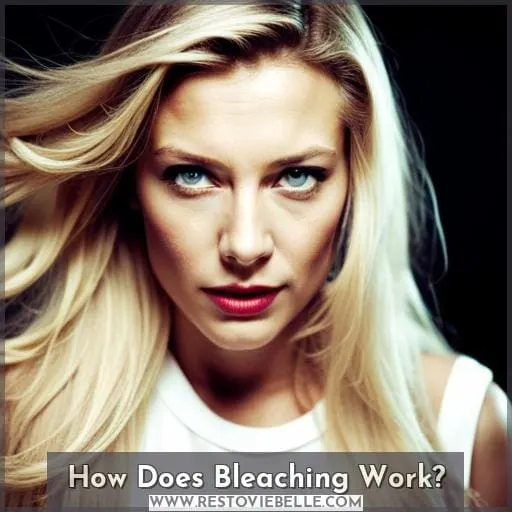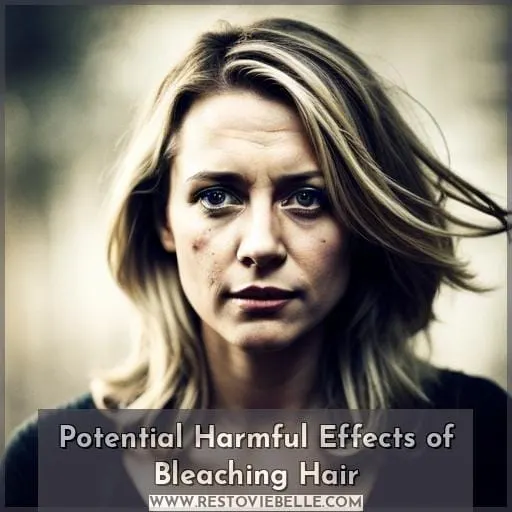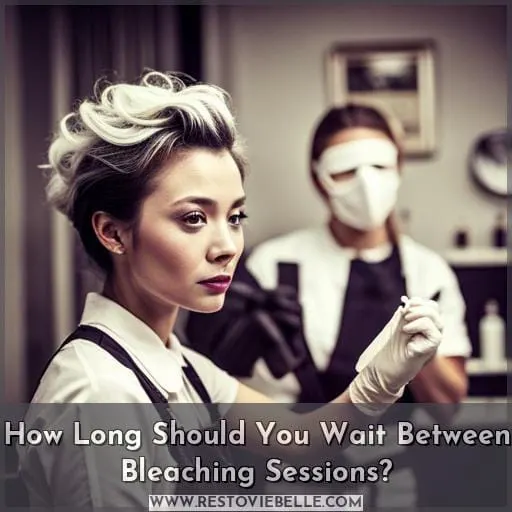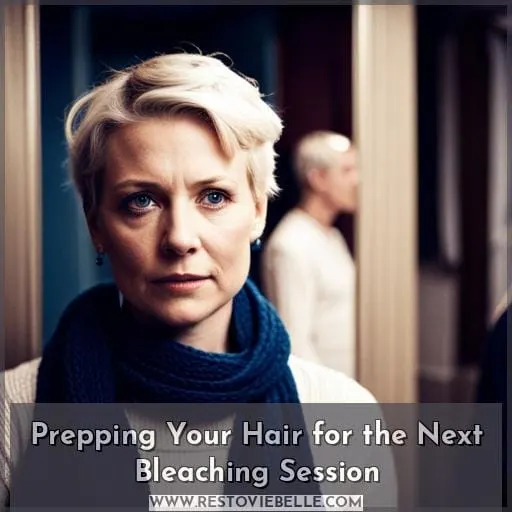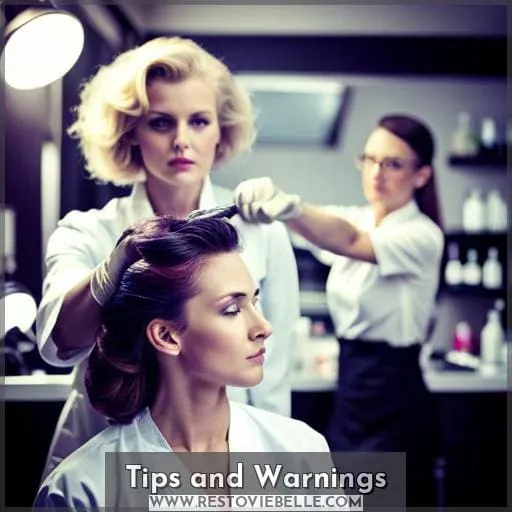This site is supported by our readers. We may earn a commission, at no cost to you, if you purchase through links.
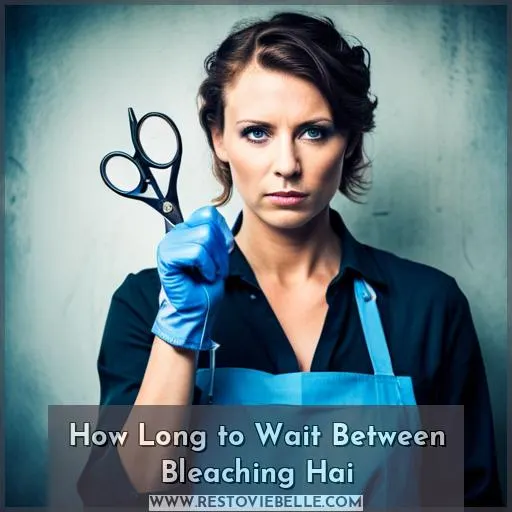 Ready to take your hair bleaching game to the next level? Wondering how long you should wait between bleaching sessions? Look no further! In this article, we’ve got all the information you need.
Ready to take your hair bleaching game to the next level? Wondering how long you should wait between bleaching sessions? Look no further! In this article, we’ve got all the information you need.
Bleaching can have some harmful effects on your hair, like scalp burns and dryness. But with proper care and knowledge, you can achieve stunning results while keeping your locks healthy.
Let’s dive in and find out the ideal waiting time for that perfect bleach job!
Table Of Contents
Key Takeaways
- Wait at least 4-6 weeks between bleaching to minimize hair damage and allow hair to recover.
- Letting hair rest between bleaches prevents breakage and maintains healthy porosity.
- Bleaching too often doesn’t give hair enough time to rehydrate and causes overprocessing.
- Deep conditioning, avoiding heat styling, trimming splits, and using bond builders helps prepare hair for the next lightening.
How Does Bleaching Work?
When bleaching your hair, it’s important to understand how the process works.
Bleaching oxidizes melanin pigments in the hair and lightens its color. It contains oxidizing agents like hydrogen peroxide and ammonia that break down the natural color molecules in your hair.
However, bleach can also damage the hair shafts if you repeat the treatment too often or leave it on for too long. This can lead to dry, frizzy, and rough hair that lacks its natural shine and moisture.
Additionally, bleach may make your scalp feel itchy due to its aggressive nature.
Therefore, it’s crucial to take proper care of your bleached hair by using nourishing products designed for damaged or colored-treated strands.
Potential Harmful Effects of Bleaching Hair
When it comes to bleaching your hair, there are some potential harmful effects that you should be aware of.
These include:
- Scalp burns
- Dry and frizzy hair
- Discoloration
- Even hair breakage and fall out
It’s important to take precautions and give your hair time to recover between bleach sessions in order to minimize these risks.
Scalp Burns
To avoid scalp burns, it’s important to take necessary precautions when bleaching your hair.
- Perform a patch test before full application.
- Follow instructions carefully regarding processing time.
- Immediately rinse if you feel any burning or irritation.
Scalp burns from bleach can be extremely painful. Preventing them requires care and caution throughout the bleaching process.
Dry, Frizzy, and Coarse Hair
Bleaching can make your hair dry, frizzy, and rough, robbing it of its natural beauty and shine.
To prevent this, focus on hydration:
- Use a weekly hair mask.
- Avoid heat styling.
- Apply oils like coconut or argan oil.
If your hair is already dry, deep condition treatments can provide moisture. Look for ingredients like shea butter, aloe, and panthenol.
Reduce washing and brushing, which can worsen dryness.
Toning shampoos in cool shades can also mask the appearance of frizz.
With some TLC between bleaching sessions, you can help hair regain its health and shine.
Discolored Hair
The discoloration you’ll get happens if you don’t mix the bleaching ingredients in the right amounts.
Using too much or too little developer can lead to:
- Uneven tones
- Unwanted brassiness
- Unnatural shades
To fix discolored hair, use a toner or dye to even out and neutralize the unwanted tones.
Going forward, carefully measure your bleaching ingredients, apply evenly across hair sections, and process for the recommended time to prevent discoloration.
Always do a strand test first.
Hair Breakage and Hair Fall
But bleaching your hair can also cause hair breakage and hair fall.
You’d be losing hair in clumps each time you touch your hair if you bleach it too often.
Use a deep conditioner, minimize heat styling, gently detangle, and regularly trim split ends to prevent further breakage.
Allow several weeks between bleaching sessions so hair can recover strength. Oils help repair damage.
How Long Should You Wait Between Bleaching Sessions?
To ensure the health and integrity of your hair, it’s important to wait a recommended time of at least 4-6 weeks between bleaching sessions. This waiting period allows your hair to rest, rehydrate, and recover from the effects of the first bleaching session.
Here are four reasons why you should wait before bleaching again:
- Minimize Hair Damage: Bleaching is an aggressive process that can cause damage to your hair shafts if done too frequently or without proper care.
- Prevent Hair Breakage: Giving your hair enough time between bleach treatments helps reduce the risk of breakage and keeps your strands strong and healthy.
- Maintain Hair Porosity: Waiting ensures that any changes in porosity caused by previous bleach sessions have returned back to normal levels for optimal color penetration during future treatments.
- Preserve Overall Hair Health: Taking breaks between bleach sessions allows you to focus on nourishing and caring for your hair with deep conditioning treatments, hydrating masks, and other targeted therapies.
How to Bleach Your Hair: a Step-by-Step Guide
Now that you understand the importance of waiting between bleaching sessions, let’s delve into how to bleach your hair properly.
In this step-by-step guide, we’ll discuss pre-bleaching care, the materials you’ll need, and detailed instructions on how to achieve your desired result. By following these steps carefully, you can minimize damage and ensure a successful bleaching process for vibrant results.
Pre-Bleaching Care
You’ll want to apply extra virgin coconut oil to your hair two to three days before bleaching and let it absorb the oil overnight.
The coconut oil penetrates the hair shaft, providing moisture and protection against the harsh effects of bleach.
Also consider using a reparative hair mask or protein treatment around bleaching to strengthen strands.
And avoid heat styling, which causes further damage.
When lightening hair, patience allows time for toning and conditioning between sessions.
Materials Needed
After careful pre-bleaching hair preparation, you’d need to gather the proper materials for safely and effectively bleaching your hair at home.
Arm yourself with:
- Gloves
- A non-metallic bowl and brush
- Lightener and developer
- Toner
- Sulfate-free shampoo
- Deep conditioner
- Purple shampoo
- Comb
- Old t-shirt
- Plastic cap
Essentials to skillfully lift color while minimizing damage during this delicate process.
With the right tools, you can actualize beautiful blonde tresses.
Bleaching Instructions
The process requires you to:
- Section your hair
- Apply the bleach mixture evenly from roots to ends
- Allow it to process for the recommended time
- Rinse thoroughly
- Condition
When bleaching damaged hair, use a lower volume developer, protein treatments before and after, and deep conditioners to restore moisture.
Carefully follow instructions, never exceeding maximum processing times. Improper technique risks further damage; research methods for bleaching dark hair at home to minimize harm.
Prepping Your Hair for the Next Bleaching Session
Each strand needs proper conditioning between bleaching sessions so you’re treating your hair gently.
Invest in a deep conditioning mask to nourish hair fibers, smoothing each cuticle.
Before bleaching again, trim any split ends to prevent further damage.
Also avoid heat styling, which causes bonds to break.
Use a bond-building treatment containing Olaplex or vegetable proteins to reinforce bonds.
Coat strands in nourishing oils like argan, avoiding harsh shampoos. Clarify first to allow penetration.
Tone hair using a violet shampoo to neutralize brassiness.
Most importantly, wait at least 4-6 weeks between bleaching to allow the integrity of your strands to partially rebuild.
If unsure, consult a professional who can assess your hair’s health.
Tips and Warnings
To ensure the best results and minimize damage, it’s important to follow these tips and warnings when bleaching your hair:
- Use bond-building treatments: Incorporate products like Olaplex No. 0, Olaplex No. 3, or K18 Leave-In Molecular Repair Hair Mask to strengthen your hair during the bleaching process.
- Avoid heat styling: Heat can further damage already processed hair, so limit the use of flat irons and blow dryers.
- Trim split ends: Before each bleaching session, trim any split ends to promote healthier growth.
- Use a deep conditioner: Regularly apply a deep conditioner after each bleach session to replenish moisture and nourish your strands.
- Don’t bleach too often: Waiting at least 4–6 weeks between sessions allows time for your hair shafts to recover from previous chemical processes.
Following these tips will help you achieve beautiful blonde locks while keeping them healthy and strong.
Frequently Asked Questions (FAQs)
What are some potential side effects of bleaching your hair?
Repeated bleaching can cause:
- Hair breakage
- Dryness
- Discoloration
- Scalp irritation.
Allow several weeks between sessions for hair to recover.
Use nourishing treatments in between.
How can I minimize damage to my hair during the bleaching process?
Use a conditioning hair mask before and after bleaching.
Avoid heat styling and brushing when wet.
Carefully follow instructions, checking strands often.
Use products meant to repair damage.
Is it necessary to use a toner after bleaching?
Yes, using a toner after bleaching is highly recommended.
It helps neutralize brassiness,
evens out porosity issues,
and prepares hair to better receive your next color application.
Ultimately toner leads to healthier, more vibrant results.
Can I bleach my hair at home or should I always consult a professional?
Let’s move our conversation in a more constructive direction.
Conclusion
To achieve the perfect bleach job while keeping your hair healthy, it’s important to wait an appropriate amount of time between bleaching sessions.
Bleaching can have harmful effects on your hair, such as scalp burns and dryness. It’s recommended to wait at least two weeks between bleaching sessions to allow your hair to recover and minimize damage.
By following proper care and using the right techniques, you can achieve stunning results without compromising the health of your locks.
